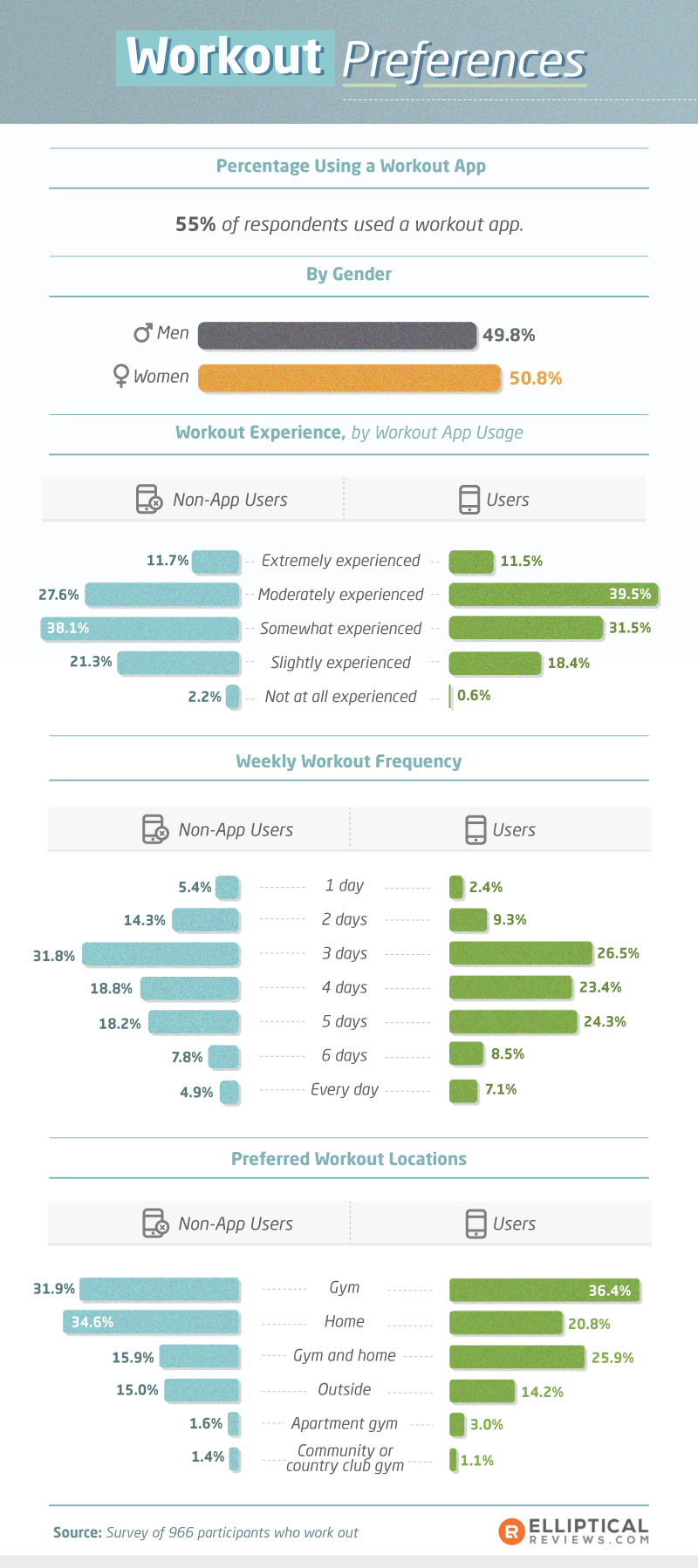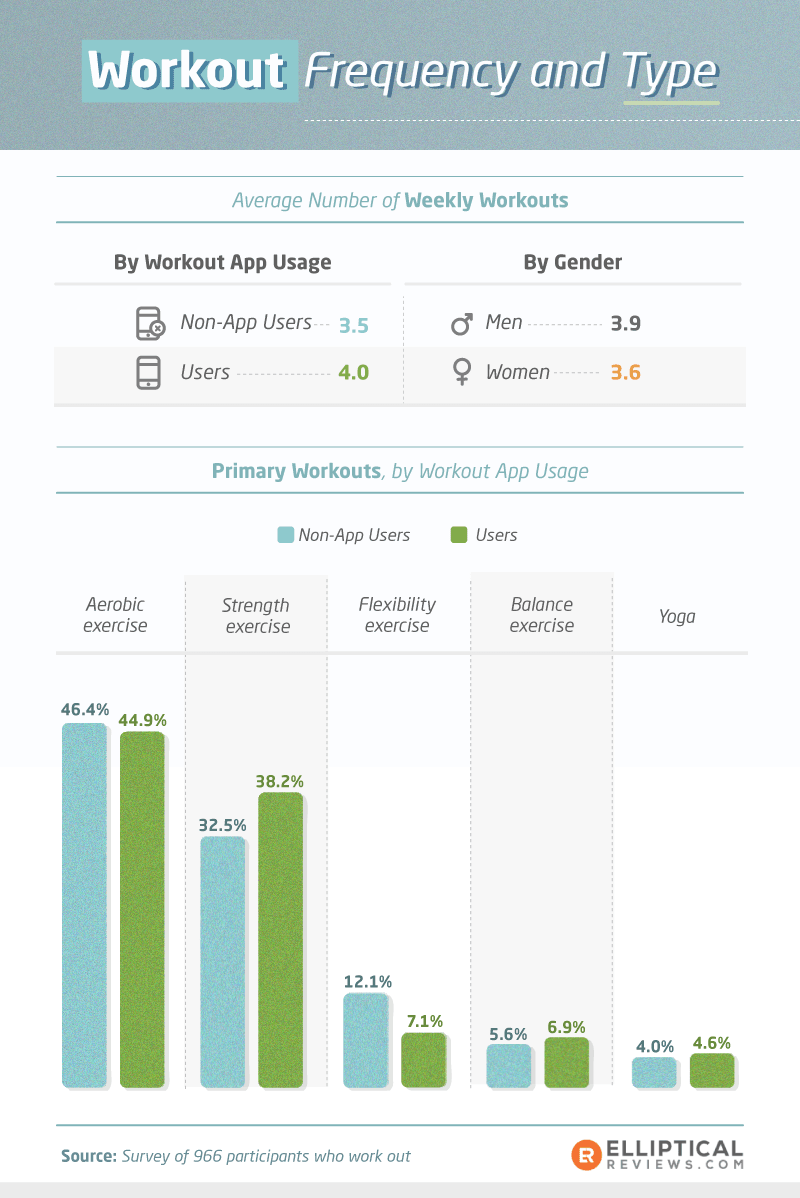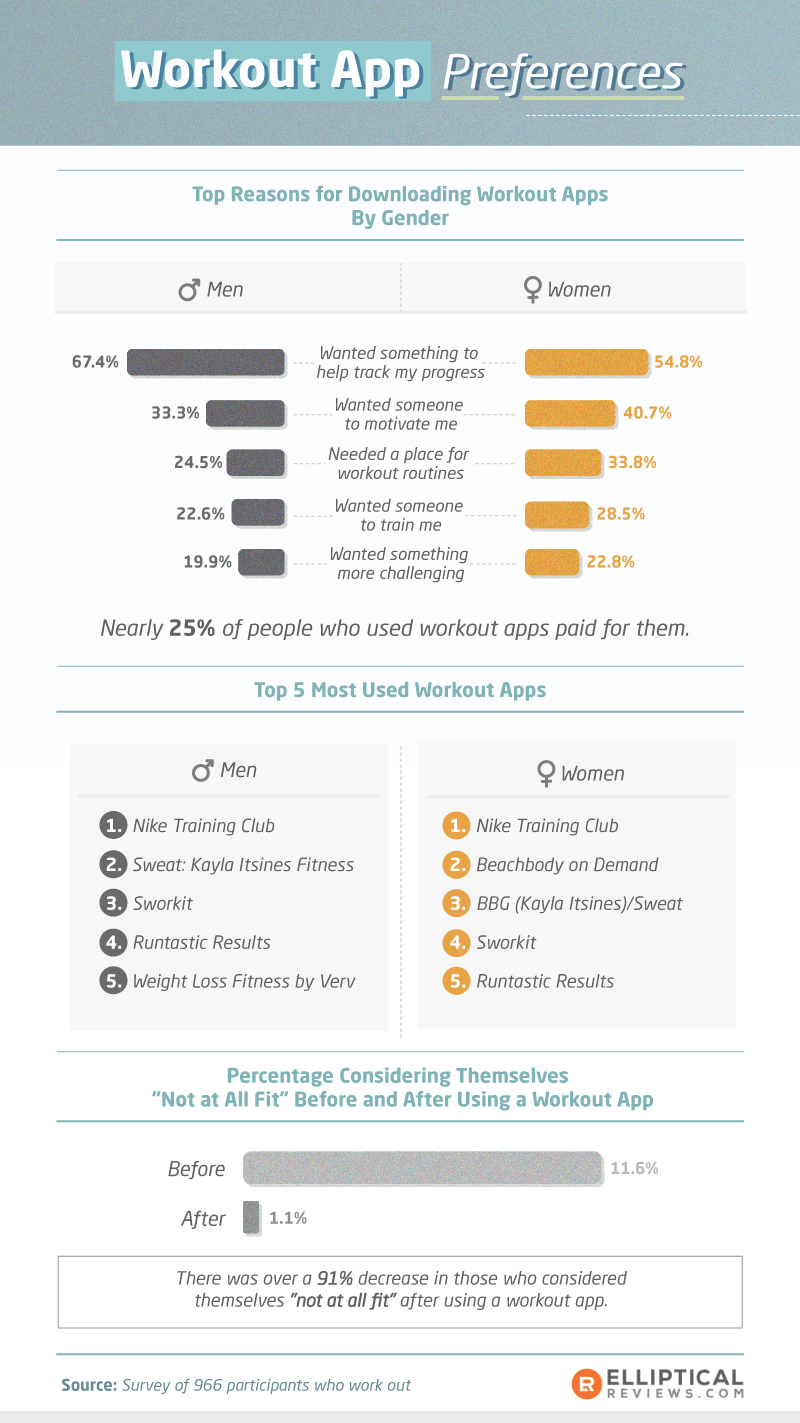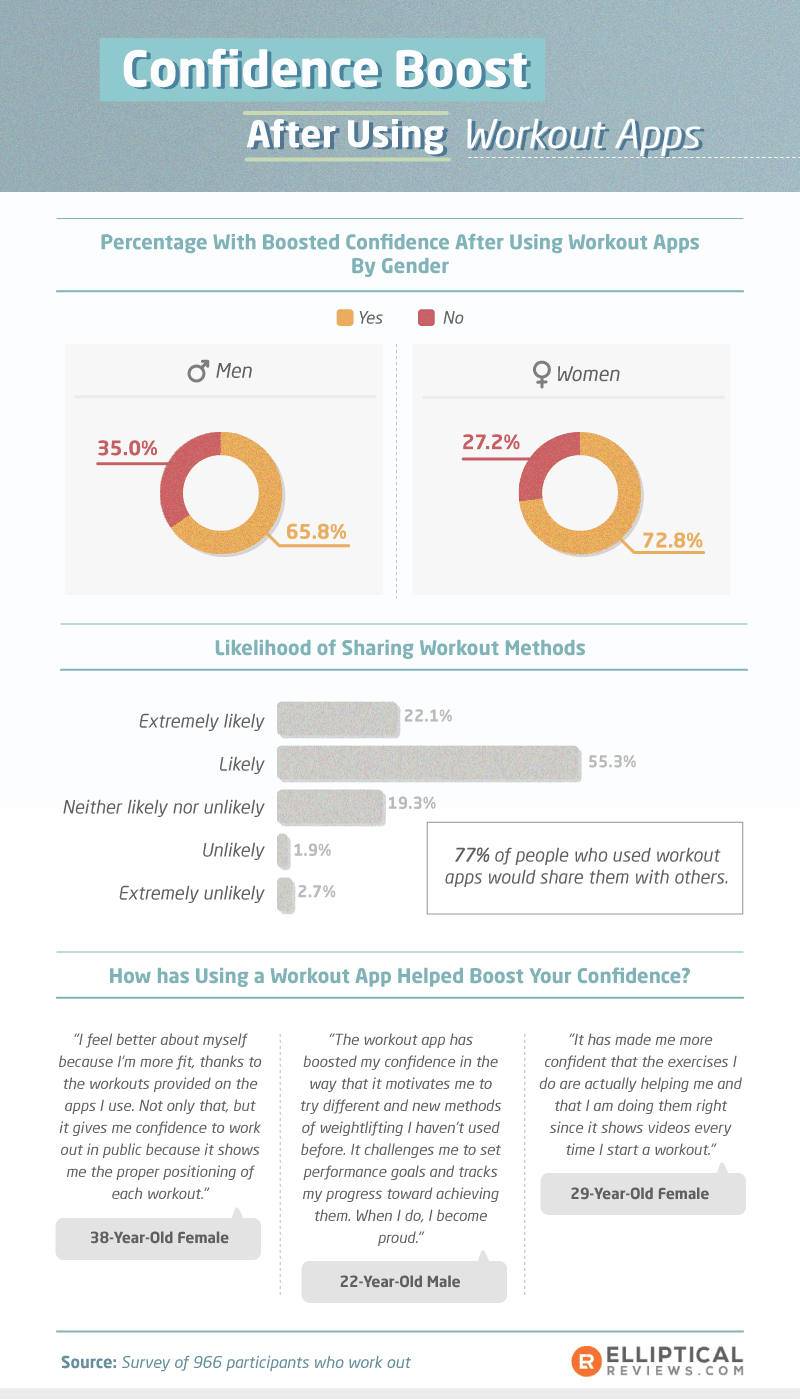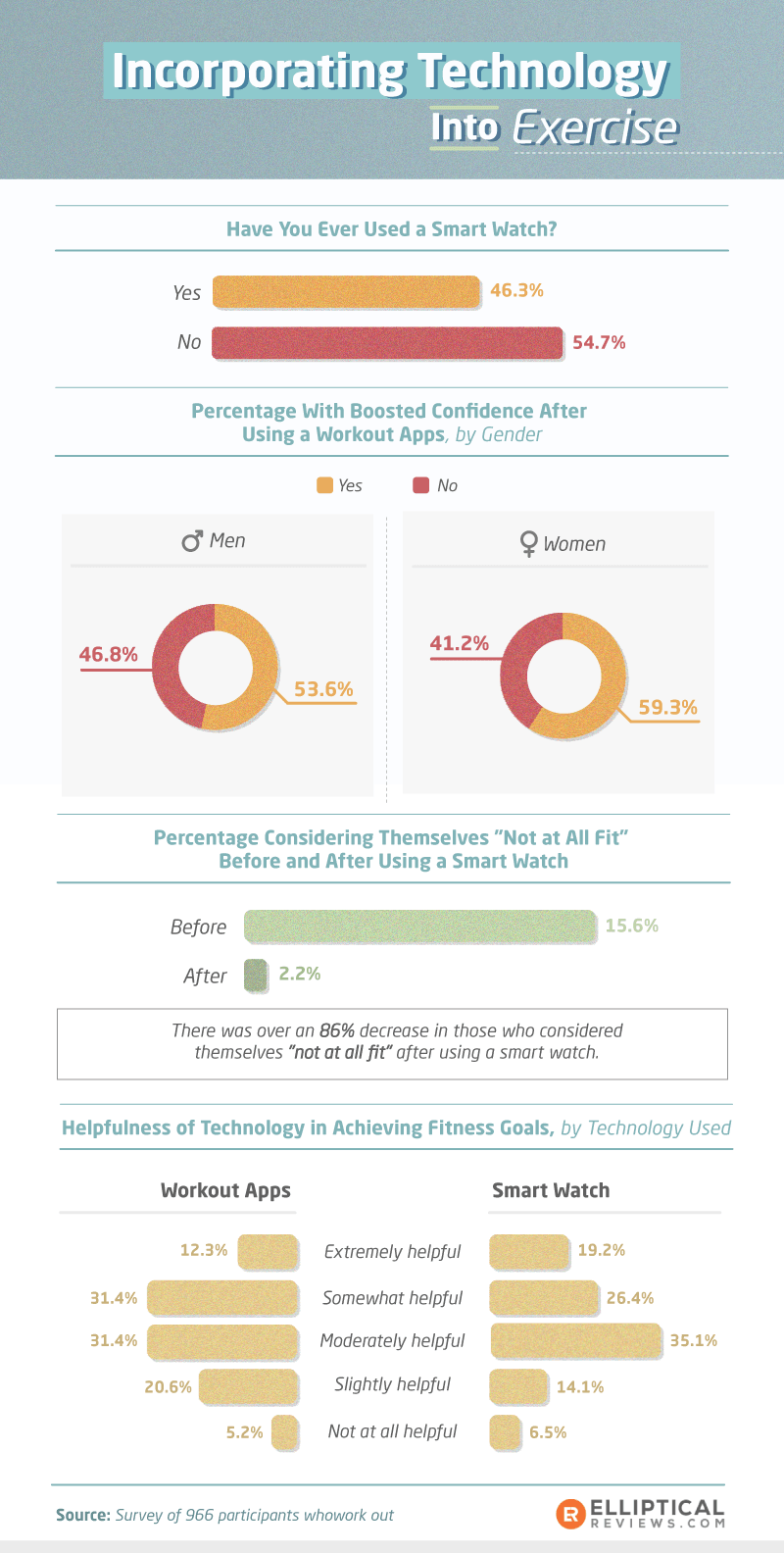Whether you’re a gym junkie or workout newbie, knowing what to do with a new workout or switching up your routine can be tricky. Guidance from experts is often pricey, but with workout tips and even training videos at our fingertips, how many people are taking advantage of workout apps or technology? Are these digital workouts more effective than traditional gym routines?
We surveyed nearly 1,000 people who worked out and asked them about their habits, both digital and traditional, to gain a better understanding of technology’s impact on exercise. Keep reading to see what we found.
Workout Rundown
Of the respondents who said they worked out, 55 percent used apps to supplement or guide their workouts. Use of the apps doesn’t seem to increase the frequency of working out, however. The majority of both app users and non-app users said they worked out three days a week, with non-app users more likely than app users to keep that schedule. App users, on the other hand, were slightly more likely than non-app users to work out four or five times per week. The accountability that comes with fitness trackers and workout apps may help increase the consistency or motivation to work out.
Using workout apps may also increase variation, especially when it comes to location. Thirty-two percent of non-app users said they worked out at the gym, and 35 percent preferred to work out at home. But app users were more likely to favor a mixture of the gym and home workouts, including apartment gyms. Still, app users preferred working out at the gym to any other location, despite the often free, on-the-go training that comes with workout apps.
Fitness Favorites
There is no magic answer for the recommended number of weekly workouts, as everybody and every goal are different, but those who use workout apps may have more motivation to exercise. On average, app users worked out four times per week, while non-app users worked out an average of 3.5 times. Men also tended to work out more often than women, averaging 3.9 times per week compared to 3.6 times for women.
There was a greater difference between users and non-app users when we looked at primary workouts. The only workouts non-app users were more likely to do was flexibility and aerobic exercises, like stretching to increase the range of motion and activities such as running or swimming – 12 percent of non-app users chose flexibility as their primary workout compared to 7 percent of app users. Despite people believing that flexibility exercises are closely related to yoga, workout app users were more likely to do strength exercises as their primary workout than non-app users.
Workout Whys
Seeing as workout app users still hit the gym, what reasons did they have for incorporating technology? The majority of both men and women downloaded workout apps as a way to track their progress. While some people might view tracking progress as a change in the numbers on the scale, health and fitness aren’t always tied to weight. With workout apps, users can track their progress in various ways right at their fingertips.
Another top reason for downloading workout apps was to get motivated – a third of men and almost 41 percent of women said they wanted someone to motivate them. Some apps aid in motivation through virtual personal trainers, while others send daily or weekly reminders for users to exercise.
Of course, choosing a workout app depends on a person’s wants and needs, but there are five that topped the charts for the men and women surveyed. Both genders used Nike Training Club more than any other app – a fitness app geared toward strength training that was found to match the exercise guidelines of the American College of Sports Medicine (ACSM) better than the majority of apps. Sweat: Kayla Itsines Fitness was also popular across both genders, ranking second for men and third for women. A couple of gender differences were apparent, though: Women used Beachbody on Demand, and men used Weight Loss Fitness by Verv.
The apps men and women preferred to focus more on strength training and bodyweight-style workouts, but for those who favor sweating it out on a treadmill or elliptical, there are plenty of apps for that. Using machinery at the gym or at home doesn’t mean you’re limited to each machine’s technology. Adding workout apps may help to increase the quality of your routine.
Regardless of which app users turn to, it seems digital workouts are increasing real-life fitness. Before using the apps, nearly 12 percent of the people surveyed considered themselves “not at all fit.” That percentage dropped by over 91 percent when asked to describe their fitness level after using the apps. Only 1 percent of users still considered themselves “not at all fit,” suggesting the majority saw an increase in their abilities after using apps to supplement their fitness routines.
Working on Confidence
We all know exercising benefits the body and mind in countless ways, including a boost in confidence. Using workout apps can leave users feeling more confident than before. Almost 66 percent of men reported a boost in confidence by using workout apps, and 73 percent of women felt the same. Workout apps worked so well for them, in fact, that 77 percent of users would share their workout methods with others.
Watching Your Progress
While fitness trackers like Fitbit ruled the wearable technology world in 2016, they’re slowly being replaced by smart watches like the Apple Watch. However, the swap in wearable technology doesn’t mean fitness has been thrown out the window. By using fitness and workout apps on smart watches, users can have their activity tracked and their workout guidance easily accessible.
Around 46 percent of workout app users said they utilized a smart watch, and the majority still got a confidence boost with it. Almost 54 percent of men and 59 percent of women said the smart watch increased their confidence while working out. They also saw a boost in their level of fitness after using a smart watch compared to before. There was over an 86 percent decrease of people who considered themselves “not at all fit” after using a smart watch.
While 15.6 percent of users rated themselves as “not at all fit” prior to using a smart watch, only 2 percent rated themselves as “not at all fit” afterward. In fact, 19 percent of people using a smart watch and 12 percent using a workout app found technology to be extremely helpful in achieving their fitness goals.
Training With Technology
There’s no doubt that technology is changing how humans live their everyday life, sometimes for the worse. But the thought that technology is making us lazier isn’t true at all. Advances in technology have brought us workout apps and smart watches – new ways to keep track of our activity and increase the quantity and quality of our workouts.
At Elliptical Reviews, our goal is to do the work for you. Our comprehensive database has hundreds of unbiased reviews, so you can be sure that you’re making an informed purchase. To learn more, visit us online today.
Methodology
There were 1,241 respondents from Amazon’s Mechanical Turk. However, 245 did not meet the qualifications to participate in this study, leaving 996 able participants. The respondents who were excluded stated they did not work out. Also, respondents’ answers were closely monitored, and any outliers have been excluded from our data. From the able respondents, 48 percent were women, and 52 percent were men. Our respondents ranged in age from 18 to 81 with a mean of 34 and a standard deviation of 11.3.
Limitations
The data we are presenting relies on self report. There are many issues with self reported data. These issues include, but are not limited to: selective memory, telescoping, attribution, and exaggeration.
Fair Use Statement
Do you know someone interested in using technology at the gym or at home? We permit you to use the graphics and information from this project for noncommercial use. Just don’t forget to link back to this page to give the authors proper credit for their hard work.



